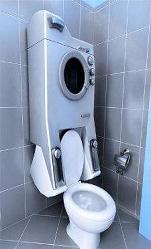| View previous topic :: View next topic |
| Author |
Message |
faceless
admin

Joined: 25 Apr 2006
|
 Posted: Sat Jul 03, 2010 4:40 pm Post subject: Fuel made from carbon dioxide and sunlight Posted: Sat Jul 03, 2010 4:40 pm Post subject: Fuel made from carbon dioxide and sunlight |
 |
|
|
|
 Car fuel made from carbon dioxide and sunlight
New technology for "photosynthesising" fuel could lead to cars running on "petrol" made from carbon dioxide and sunlight.
Car fuel made from carbon dioxide and sunlight
New technology for "photosynthesising" fuel could lead to cars running on "petrol" made from carbon dioxide and sunlight.
By Tom Chivers
2 Jul 2010
Solar-powered reactors can take carbon dioxide and turn it into carbon monoxide. The same reactors can also be used to turn water into hydrogen and oxygen. The two can then be reacted together with a catalyst to form hydrocarbon fuels, in a technique known as the Fischer-Tropsch process. Fuels made in this way are sufficiently similar to those currently used in cars that major redesigns of engines and refuelling stations should not be necessary. If fuels can be made entirely from atmospheric carbon, running a car on that fuel would be carbon neutral.
One such machine, the Counter Rotating Ring Receiver Reactor Recuperator (CR5), created by a team of scientists at Sandia National Laboratories in Albuquerque, New Mexico, captures carbon dioxide from power plant exhaust fumes. In the future, however, they hope to extract it directly from the air. The system uses a giant parabolic mirror, which concentrates sunlight on to two chambers separated by spinning rings of cerium oxide. As the rings turn, the cerium oxide is heated to 1500C and releases oxygen into one of the chambers. The oxygen is then pumped away. As the ring spins, the now de-oxidised cerium moves into the other chamber. Carbon dioxide is pumped in, and the deoxidised cerium steals one of the oxygen molecules, creating carbon monoxide and cerium oxide.
Another team, the Swiss Federal Institute of Technology, Zurich, uses a similar system, but with calcium oxide, zinc oxide and steam, which can create a stream of hydrogen and carbon monoxide. Their system can already use atmospheric carbon dioxide. At the moment the two reactors have problems. The New Mexico team's system currently only works for a few seconds at a time, while the Swiss model runs at a mere 10 kilowatts. But both hope to improve reliability and yield.
Creating usable fuel from solar energy is a promising way of keeping the world's energy demands satisfied while minimising carbon emissions, Ken Caldeira of the Carnegie Institution of Washington at Stanford University, California told New Scientist. "This area holds out the promise for technologies that can produce large amounts of carbon-neutral power at affordable prices, which can be used where and when that power is needed," he says. "It is one of the few technology areas that could truly revolutionise our energy future."
----------------------
Now that's good technology. A few years of development and it could be perfect. Perfect in as much as normal users won't have to do anything to help the planet... as most really don't care. |
|
| Back to top |
|
 |
faceless
admin

Joined: 25 Apr 2006
|
 Posted: Tue Jul 06, 2010 6:52 pm Post subject: Posted: Tue Jul 06, 2010 6:52 pm Post subject: |
 |
|
|
|
Power of Innovation
The solar dish Stirling technology is well beyond the research and development phase, with more than 20 years of recorded operating history. The equipment is well characterized with over 50,000 hours of on-sun time. Since 1984, the Solar Dish Stirling equipment has held the world's efficiency record for converting solar energy into grid-quality electricity. This record was achieved when the technology was installed in Huntington Beach, California. SES coordinated with the U.S. Department of Energy and Sun-Labs (National Renewable Energy Laboratory and Sandia National Laboratories) to conduct an endurance test of the solar dish Stirling system and to bring the technology to market.
SunCatcher™ Technology ::
How It Works
The SunCatcher™ is a 25-kilowatt-electrical (kWe) solar dish Stirling system which consists of a unique radial solar concentrator dish structure that supports an array of curved glass mirror facets, designed to automatically track the sun, collect and focus, that is, concentrate, its solar energy onto a patented Power Conversion Unit (PCU). The PCU is coupled with, and powered by, a completely re-engineered SES Stirling engine that generates power grid-quality electricity.
Power Conversion Unit (PCU)
The PCU converts the focused solar thermal energy into grid-quality electricity. The conversion process in the PCU involves a closed-cycle, high-efficiency four-cylinder, reciprocating Solar Stirling Engine utilizing an internal working fluid that is recycled through the engine. The Solar Stirling Engine operates with heat input from the sun that is focused by the SunCatcher’s™ dish assembly mirrors onto the PCU's solar receiver tubes which contain hydrogen gas. The PCU solar receiver is an external heat exchanger that absorbs the incoming solar thermal energy. This heats and pressurizes the gas in the heat exchanger tubing, and this gas in turn powers the Solar Stirling Engine.
A generator is connected to the Solar Stirling Engine; and produces the grid-quality electrical output of the SunCatcher™. Waste heat from the engine is transferred to the ambient air via a radiator system similar to those used in automobiles. The gas is cooled by a radiator system and is continually recycled within the engine during the power cycle. The conversion process does not consume water, as is required by most thermal-powered generating systems.
New Radial Dish Design
The SunCatcher™ uses an innovative radial design for its concentrating mirrors. At sunrise, each SunCatcher automatically rotates to face The Sun, and with sophisticated automation software, tracks, collects, and focuses the sun’s energy onto a single point, the Power Conversion Unit.
www.stirlingenergy.com/how-it-works.htm
-------------------
James Bond style... I like it! |
|
| Back to top |
|
 |
gordonrussell

Joined: 22 Oct 2011
Location: Glasgow UK
|
|
| Back to top |
|
 |
|
|
|
|
You cannot post new topics in this forum
You cannot reply to topics in this forum
You cannot edit your posts in this forum
You cannot delete your posts in this forum
You cannot vote in polls in this forum
You can attach files in this forum
You can download files in this forum
|
Couchtripper - 2005-2015
|




